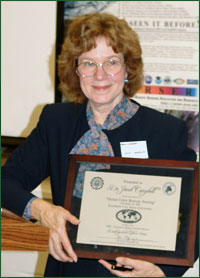 Janet
W. Campbell Janet
W. Campbell
Research
Professor
Bio-optical
Oceanography/Remote Sensing
Ph.D.,
Virginia Polytechnic
Institute
Janet
Campbell is director
of the Center of Excellence
for Coastal Ocean Observation
and Analysis (COOA) that
was established in August
2002 as part of NOAA's
Coastal Observation Technology
System (COTS). The UNH
center of excellence
specializes in the development
of new methodologies
for understanding coastal
marine ecosystems, the
fate of land-derived
carbon and other elements
in the coastal ocean,
and the effect of climate
change and human activity
on the coastal ocean.
COOA is working in partnership
with other institutions
in the northeast to form
a regional coastal ocean
observing system that
will become part of a
national network. Our
collective goal is to
establish a sustainable
program of coastal ocean
observations, analysis,
and enabling technology
development focused on
delivering information
useful to scientists,
educators, resource managers,
policy makers, and of
interest to the general
public.
Dr.
Campbell leads the Bio-Optical
Oceanography Group, an
informal team of research
scientists and graduate
students within the Ocean
Process Analysis Laboratory
of EOS. Bio-optical oceanography
is an emerging field
of ocean science that
concerns the interaction
of light with marine
organisms and biogeochemical
processes. This multidisciplinary
field combines the physics
of radiative transfer,
the biology of photosynthesis,
phytoplankton ecology,
and the photochemistry
of materials found in
the sea. It is also the
basis for ocean color
remote sensing, which
is the focus of the group's
NASA-funded research
projects.
The
Bio-Optical Oceanography
Group is developing techniques
for studying biological
and biogeochemical processes
in the ocean using satellite
remote sensors. Their
primary sources of data
are ocean color satellite
sensors such as the Sea-viewing
Wide Field-of-view Sensor
(SeaWiFS) and the Moderate
Resolution Imaging Spectroradiometer
(MODIS). They are modeling
the effects of phytoplankton,
dissolved organic materials,
suspended sediments,
and other particles on
the spectral radiance
measured by these satellites,
and exploring inversion
techniques for using
the satellite ocean color
data to map these substances.
In addition, techniques
are being developed for
estimating primary productivity
in coastal waters, and
for blending regional
models for coastal applications.
Dr. Campbell is a member
of NASA's Ocean Color
Science Team and the
MODIS Instrument Team.
She has been at UNH
since 1993, and is a member
of the Graduate Faculty
in the Earth Sciences
Department. Between
1997-99, she served as the
Program Manager for Ocean
Biology and Biogeochemistry
at NASA Headquarters in
Washington, D.C. Before
coming to UNH, she
was a research scientist
at the Bigelow Laboratory
for Ocean Sciences
in Boothbay Harbor, Maine
(1982-93), where she
established and directed
the remote sensing
computer facility. She previously
worked as an Aerospace
Technologist/Engineer
at the NASA Langley
Research Center in Hampton,
Virginia. She holds a Ph.D.
degree is in statistics from
Virginia Polytechnic
Institute, a Masters
degree in mathematics
from Vanderbilt University,
and a Bachelor of Arts
degree in mathematics,
with high honors, from
Mary Baldwin College
From:
http://www.eos.sr.unh.edu/Fac/People?FAC_ID=12
|

